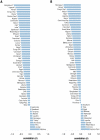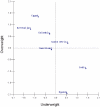Global burden of double malnutrition: has anyone seen it?
- PMID: 21980384
- PMCID: PMC3182195
- DOI: 10.1371/journal.pone.0025120
Global burden of double malnutrition: has anyone seen it?
Abstract
Background: Low- to middle-income countries (LMICs) are believed to be characterized by the coexistence of underweight and overweight. It has also been posited that such coexistence is appearing among the low socioeconomic status (SES) groups.
Methods: We conducted a cross-sectional analysis of nationally representative samples of 451,321 women aged 20-49 years drawn from 57 Demographic and Health Surveys conducted between 1994 and 2008. Body Mass Index (BMI in kg/m²), was used to define underweight and overweight following conventional cut-points. Covariates included age, household wealth, education, and residence. We estimated multinomial multilevel models to assess the extent to which underweight (BMI<18.5 kg/m²) and overweight (BM I≥ 25.0 kg/m²) correlate at the country-level, and at the neighborhood-level within each country.
Results: In age-adjusted models, there was a strong negative correlation between likelihood of being underweight and overweight at country- (r = -0.79, p<0.001), and at the neighborhood-level within countries (r = -0.51, P<0.001). Negative correlations ranging from -0.11 to -0.90 were observed in 46 of the 57 countries at the neighborhood-level and 29/57 were statistically significant (p ≤ 0.05). Similar negative correlations were observed in analyses restricted to low SES groups. Finally, the negative correlations across countries, and within-countries, appeared to be stable over time in a sub-set of 36 countries.
Conclusion: The explicitly negative correlations between prevalence of underweight and overweight at the country-level and at neighborhood-level suggest that the hypothesized coexistence of underweight and overweight has not yet occurred in a substantial manner in a majority of LMICs.
Conflict of interest statement
Figures





Similar articles
-
Weight of communities: a multilevel analysis of body mass index in 32,814 neighborhoods in 57 low- to middle-income countries (LMICs).Soc Sci Med. 2012 Jul;75(2):311-22. doi: 10.1016/j.socscimed.2012.02.014. Epub 2012 Apr 10. Soc Sci Med. 2012. PMID: 22541801
-
Double burden of malnutrition among women of reproductive age in 55 low- and middle-income countries: progress achieved and opportunities for meeting the global target.Eur J Clin Nutr. 2022 Feb;76(2):277-287. doi: 10.1038/s41430-021-00945-y. Epub 2021 May 26. Eur J Clin Nutr. 2022. PMID: 34040202 Free PMC article.
-
Correlates of the double burden of malnutrition among women: an analysis of cross sectional survey data from sub-Saharan Africa.BMJ Open. 2019 Jul 3;9(7):e029545. doi: 10.1136/bmjopen-2019-029545. BMJ Open. 2019. PMID: 31272983 Free PMC article.
-
Fertility is a key predictor of the double burden of malnutrition among women of child-bearing age in sub-Saharan Africa.J Glob Health. 2020 Dec;10(2):020423. doi: 10.7189/jogh.10.020423. J Glob Health. 2020. PMID: 33110582 Free PMC article. Review.
-
Prevalence of malnutrition among children and women of reproductive age in Uruguay by socio-economic status and educational level.Public Health Nutr. 2020 Aug;23(S1):s101-s107. doi: 10.1017/S1368980020000804. Epub 2020 Apr 17. Public Health Nutr. 2020. PMID: 32299530 Free PMC article. Review.
Cited by
-
Change in the body mass index distribution for women: analysis of surveys from 37 low- and middle-income countries.PLoS Med. 2013;10(1):e1001367. doi: 10.1371/journal.pmed.1001367. Epub 2013 Jan 15. PLoS Med. 2013. PMID: 23335861 Free PMC article.
-
Spatial distribution and determinants of undernutrition among reproductive age women of Ethiopia: A multilevel analysis.PLoS One. 2021 Sep 20;16(9):e0257664. doi: 10.1371/journal.pone.0257664. eCollection 2021. PLoS One. 2021. PMID: 34543339 Free PMC article.
-
Household food insecurity in Mexico is associated with the co-occurrence of overweight and anemia among women of reproductive age, but not female adolescents.Matern Child Nutr. 2017 Oct;13(4):e12396. doi: 10.1111/mcn.12396. Epub 2016 Dec 14. Matern Child Nutr. 2017. PMID: 27966839 Free PMC article.
-
Socio-economic influences on anthropometric status in urban South African adolescents: sex differences in the Birth to Twenty Plus cohort.Public Health Nutr. 2015 Nov;18(16):2998-3012. doi: 10.1017/S1368980015000415. Epub 2015 Mar 11. Public Health Nutr. 2015. PMID: 25757478 Free PMC article.
-
National Economic Development Status May Affect the Association between Central Adiposity and Cognition in Older Adults.PLoS One. 2016 Feb 10;11(2):e0148406. doi: 10.1371/journal.pone.0148406. eCollection 2016. PLoS One. 2016. PMID: 26863443 Free PMC article.
References
-
- Lukito W, Wahlqvist ML. Weight management in transitional economies: the “double burden of disease” dilemma. Asia Pac J Clin Nutr. 2006;15(Suppl):21–29. - PubMed
-
- Popkin BM. The nutrition transition in low-income countries: an emerging crisis. Nutr Rev. 1994;52:285–298. - PubMed
-
- World Health Organization/FAO. Report of the Joint WHO/FAO Expert Consultation on Diet, Nutrition and the Prevention of Chronic Diseases. Geneva: World Health Organization; 2002.
-
- Monteiro CA, Conde WL, Popkin BM. Is obesity replacing or adding to undernutrition? Evidence from different social classes in Brazil. Public Health Nutr. 2002;5:105–112. - PubMed
MeSH terms
LinkOut - more resources
Full Text Sources
Medical

